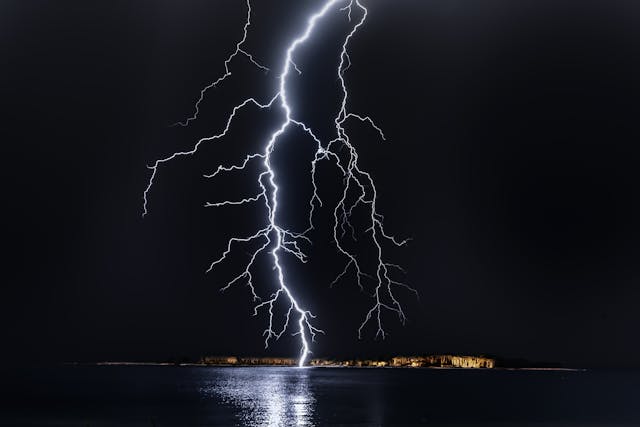
What happens if you get struck by lightning? If you do get struck by lightning, which is more common than you might imagine, it can cause severe burns, damage to the nervous system, cardiac arrest, a lot of other damage, and death.
It is estimated that 240,000 people a year are struck by lightning, and roughly 24,000, or 10%, of them die. It is difficult to get exact data because a lot of people don’t go to the hospital and it can be difficult to work out if lightning was the cause of death when a body is found. The majority of the people that survive are left with some kind of injury that can severely alter their standard of living. Being struck by lightning is not something you walk away from easily. Lightning is an electrical discharge from the clouds to the ground. The typical lightning bolt has 300 million volts of electricity and 30,000 amps. To put that in perspective, most countries in the world use 120 volts and 15 amps to power appliances in the house.
Lightning is caused when an electrical charge builds up in the clouds. In a storm, hot air rises up and swirls around in vortexes. As it gets higher, it cools, and some of the water it is carrying freezes into tiny ice crystals. These tiny ice crystals are called graupel. As the wind swirls them around, the ice crystals bang into each other, and static electricity slowly builds up. You can see something similar in a grain silo. When grain is poured in through the top, tiny pieces of grain dust swirl around, building up static electricity, and they can explode. In the clouds, this static electricity builds up until it is too much for the clouds to hold, and when it is this strong, it is attracted to the closest point which has an opposite charge. This is the ground and whatever is highest on the ground at that point. Lightning is a spark that jumps from the clouds to the ground in roughly 0.2 seconds. It has so much energy and it is so hot that it heats the surrounding air to almost 30,000℃ in milliseconds. The heated air instantly expands, causing a pressure wave that we hear as thunder. You can tell how far away a storm is by counting the seconds after you see the flash of lightning because they originated at the same time. Multiply the number of seconds by the speed of sound (343 m/s), and you know roughly how far away the storm is.
So, what happens when a person is hit by lightning? Well, it depends on how you are hit. There are several different ways you can be hit. The most dangerous is a direct strike. This is where the lightning bolt leaves the cloud, hits the person directly, and then passes into the ground. This is very rare because it is rare for a person to be one of the highest points on the ground. This accounts for 5% of strikes. The second way, which is more common, is called a side flash. This is when the lightning bolt hits something else, like a tree, and then jumps into a person standing under that tree. This, by the way, is the main reason why you shouldn’t hide under a tree when there is a thunderstorm. The tree is usually the highest point and it will attract the lightning bolt. This is also 5% of strikes. The third way is through the ground. When lightning hits a tree or a flagpole, it shoots down to the ground. However, there is so much energy that the current will travel across the ground and up into anything nearby. A lot of people and animals are killed by this. The fourth way is through conduction. If you are standing by something metal, like a fence, the lightning might hit something else and then be conducted along the fence to you. The third and fourth ways are the most common and account for 80% of strikes. And the last way is by something called a streamer. As lightning approaches the ground, an electric charge rises up from the ground to meet it. This happens so quickly that you can’t see it. Often, there is just one of these leaders, but sometimes there can be more than one, and they are just as dangerous as the lightning. This accounts for about 10% of strikes.
The most common cause of death when hit by lightning is cardiac arrest. Our hearts beat many times a minute to push blood around our body and the contractions of the heart muscle are caused by electric signals from the brain. Lightning introduces so much electricity to the body that it overwhelms everything and shuts down the heart. If there is an AED nearby, the heart can be restarted, but this is the biggest cause of death. The lightning can also shut down the lungs as well,l and people will suffocate. CPR can save people in this state. There may be extensive nerve damage as well. The lightning bolt can cause paralysis that might pass. The lightning bolt also causes burns because of the intense heat. It can burn the skin, and also the organs. The energy in the lightning bolt can rupture capillaries under the skin as well, creating interesting patterns. Lightning is not fatal in 90% of cases, but these are usually where the strike is not direct. People that do survive may have a host of other problems that persist, generally caused by the electrical overload in the body. These can be hearing problems, irregular heartbeats, memory problems, nerve damage, and other things too. And this is what I learned today.
Try these next:
Sources
https://www.nssl.noaa.gov/education/svrwx101/lightning
https://en.wikipedia.org/wiki/Lightning_injury
https://www.livescience.com/health/what-happens-if-you-get-struck-by-lightning-and-survive
https://www.weather.gov/safety/lightning-struck
Photo by Philippe Donn: https://www.pexels.com/photo/photo-of-lightning-1114690/
